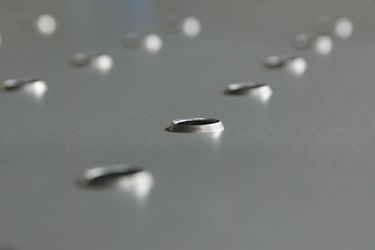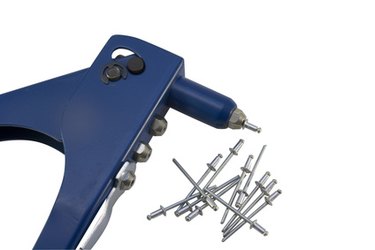Things You'll Need
Heavy gloves
Aluminum sheet
Clamps
Metal shears
Rotary tool with cutoff, grinding and polishing wheels
Drill with drill bits
Blind rivets
Blind-rivet puller
Permanent marker
Ruler

Sheet aluminum has a high strength-to-weight ratio and is a light metal. Metal workers can manipulate it by bending, cutting and rolling it. Using handheld blind rivets, or pop rivets, is a good way to secure and attach pieces of sheet metal. Even workers or do-it-yourselfers at home can quickly become efficient at using blind rivets. They require a special tool for installation, but they don't require two people, pneumatic equipment or the specialized skill needed to work with their cousin, the solid rivet, or buck rivet.
Metal Preparation
Step 1
Cut the aluminum to the needed size. You can use metal shears if you're working with thin sheets of aluminum. You'll want to use an electric or pneumatic rotary tool with a cutoff wheel for heavy pieces.
Video of the Day
Step 2
Finish your rough edges. You may have left dangerously sharp edges after cutting your sheet metal. Install a grinding wheel on your rotary tool to remove large and especially jagged parts, and then finish the edges with a polishing wheel.
Step 3
Lay out your hole pattern. Use your ruler to measure your hole locations and mark them with a permanent marker.
Step 4
Clamp the sheet metal in place. Drill your rivet holes through every piece of material that will be riveted while the pieces are clamped securely together, if the rivets are going to be installed into new locations. If there are already rivet holes, clamp the pieces together and install your rivets.
Rivet Installation
Step 1
Place an appropriate rivet in a hole. It should be slightly smaller than the hole diameter and it should have a grip length equal to the total length of all the material being riveted.
Step 2

Position the rivet puller so that the small hole at the end of the nose fits over the protruding rivet stem.
Step 3
Squeeze the handle while pressing the rivet gun down to keep the rivet head flush with the metal. The stem will pull through and break off as your rivet is secured. Repeat this for every rivet.
Tip
You can use a pneumatic rivet puller if you have one, but a hand puller is almost always adequate.
Blind rivet grip length is measured in sixteenths of an inch and is indicated by the last digit of the rivet part number.
Warning
Wear your heavy gloves when cutting, polishing and grinding aluminum. You can take the gloves off when you are sure the sharp edges have been removed.
Video of the Day